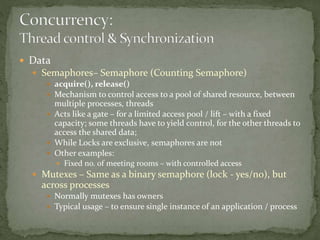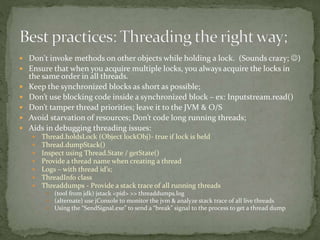Threading in java - a pragmatic primer
- 2. Concepts When & Why do we need threads Threads in java Concurrency: Thread control & Synchronization Concurrency: Data management between threads Best practices: Threading the right way; Q&A
- 3. Processes A Process has a self-contained execution environment; an application, in general terms – with own memory address space; with a main execution thread; which can own O/S resource handles – files, sockets etc. 1..* threads; Each process has one Main thread; System threads – GC, Object finalization, JVM housekeeping Timers and User created threads Threads Execution unit – to execute a sequence of instructions Owns: Stack, Program Counter, Local variables Shares: Memory, Filehandles, Process States ThreadGroups Grouping threads into a logical collection; Not used much. ThreadPools A thread pool is a collection of threads set aside for a specific task; Ex: webserver thread pool; saves thread creation overheads everytime; execute(Runnable command) Used for executing large numbers of asynchronous tasks provide a boundary mechanism to create and managing the resources within the pool Better thread management; Cleaner shutdown of threads; Ability to Add, Remove, Enumerate future tasks; Apt for a scheduler;
- 4. Multitasking – Receive data via a socket & write to file(s) A Server handling multiple concurrent requests to serve data Make the UI more responsive Number crunching; Bulk data processing; Take advantage of multiprocessor systems Simplify program logic when there are multiple independent entities Perform blocking I/O without blocking the entire program Ex: A Webserver A real time device monitor to display device parameters A Monitoring application, polling multiple sources & providing live updates
- 7. Runnable Interface & Thread Class, Daemon threads Instantiate the “Thread” Class with a “Runnable” implementation (preferred way!) Subclass the “Thread” class & override the “run” method Start – begin execution setDaemon – thread will be terminated by VM during shutdown; normal threads won’t; sleep Sleeps are not precise; Sleep either in ms or ns The Sleep can be interrupted, by other threads via the thread.interrupt call Yield (rarely used) - Relinquish control ; during long running operations; Interrupt Interrupts the wait state of the thread; invoked by the thread owner; Raises a InterruptedException
- 8. Join Makes the calling thread wait until other thread completes; Typical usage: make sure all the child threads are terminated; Can be interrupted by the thread.interrupt call wait Notify – Wakes up the thread waiting on the given object’s monitor notifyAll – Wakes up all the threads waiting on the given object’s monitor Obselete methods suspend resume Stop – use internal flags, join, wait & interrupt mechanisms instead
- 9. Timers, TimerTask (Daemon) Schedule tasks (Runnable) for future execution in a background thread. Tasks may be scheduled for one-time execution, or for repeated execution at regular intervals Schedule (task, delay) ThreadFactory Help create threads of a given type; subclassed threads ThreadInfo Contains the information about a thread ThreadReference Object ref. with additional access to thread-specific information from the target VM. Provides access to internal stack frames, monitor references.
- 10. Why Synchronization Prevent shared data corruption / thread interference / data integrity Code Locks (Monitors)- Synchronized, Volatile Each object in java has a unique monitor. When a synchronized method / block is invoked by the thread, the thread tries to take ownership of the monitor or block until it gets the ownership; The Thread acquires the monitor for the given object (ex:this / method, class object ref.). A monitor is automatically released when the method / block execution completes. Only one thread at a time can own an object's monitor. Synchronized Protect Code & Make data changes visible Block level Method level (uses intrinsic lock of the method’s object instance) Volatile – bypass processer cache to use main memory One thread – One Lock – anytime Locks will be released in the event of any uncaught exceptions Lock Interface for better control than “Synchronized” A single Lock can have multiple Conditions ReentrantLock – lock() ; Try... Finally{ unlock(); } ReentrantReadWriteLock - to get a read / write or both locks
- 12. Data Semaphores– Semaphore (Counting Semaphore) acquire(), release() Mechanism to control access to a pool of shared resource, between multiple processes, threads Acts like a gate – for a limited access pool / lift – with a fixed capacity; some threads have to yield control, for the other threads to access the shared data; While Locks are exclusive, semaphores are not Other examples: Fixed no. of meeting rooms – with controlled access Mutexes – Same as a binary semaphore (lock - yes/no), but across processes Normally mutexes has owners Typical usage – to ensure single instance of an application / process
- 13. ThreadLocal<T> Provide Local variables for the thread (can be accessed only within this thread) Each thread holds an implicit reference to its copy of a thread-local variable as long as the thread is alive When a thread dies; the thread local variables are subject to GC Java.utils.concurrent ThreadPoolExecutor, ScheduledThreadPoolExecutor Java.util.Collections classes with built in support for handling concurrency & access from multiple threads; uses collection segmentation & hence supports non-blocking – ex: the whole collection is not locked; ConcurrentHashMap ConcurrentLinkedDeque ConcurrentLinkedQueue ConcurrentSkipListMap ConcurrentSkipListSet Make normal collections thread safe via - java.util.Collections methods; blocking – ex: whole collection is locked; SynchronousQueue SynchronizedCollection SynchronizedSet SynchronizedList SynchronizedMap SynchronizedSortedSet SynchronizedSortedMap
- 14. Deadlock T1 -> W1; T1.DoSomething waits for W2. T2 -> W2; T2.DoSomething waits for W1. Hard to debug – but jConsole, jStack helps (demo with jConsole); Simplify locks / avoid arbitrary synchronization Race Condition A race condition occurs when 2 or more threads access shared data and they try to change it at the same time; problems occur when one thread does a "check-then-act" and another thread does something to the value in between the "check" and the "act“; tip: avoid ‘check & act’ situations when using threading;
- 15. White-boarding & Brainstorming Document / Comment all threading code; Be Aware of the synchronized keyword used as part of the method name – it is easy to miss if that a synchronized method uses an intrinsic lock; synchronized blocks are easier to spot; Thorough Code Reviews Use locks judiciously – lock while writes Wait for spawned threads to complete, or force stop Exception handling – a thread will terminate on an unhandled exception Make use of Thread.setDefaultUncaughtExceptionHandler -handler for all threads in the VM or setUncaughtExceptionHandler(Thread.UncaughtExceptionHandler eh) - handler for single specific thread Use immutable classes – Ex: String, Integer, BigDecimal, as they make concurrency handling simple Know when JVM performs the synchronization for you: Static Initializer, final fields, Creating objects before threads Avoid nested locks; to prevent deadlocks;
- 16. Don't invoke methods on other objects while holding a lock. (Sounds crazy; ) Ensure that when you acquire multiple locks, you always acquire the locks in the same order in all threads. Keep the synchronized blocks as short as possible; Don’t use blocking code inside a synchronized block – ex: Inputstream.read() Don’t tamper thread priorities; leave it to the JVM & O/S Avoid starvation of resources; Don’t code long running threads; Aids in debugging threading issues: Thread.holdsLock (Object lockObj)- true if lock is held Thread.dumpStack() Inspect using Thread.State / getState() Provide a thread name when creating a thread Logs – with thread id’s; ThreadInfo class Threaddumps - Provide a stack trace of all running threads (tool from jdk) jstack <pid> >> threaddumps.log (alternate) use jConsole to monitor the jvm & analyze stack trace of all live threads Using the “SendSignal.exe” to send a “break” signal to the process to get a thread dump
- 17. Threading explained in simple terms- http://www.tutorialspoint.com/java/java_multithreading.htm http://www.tutorialspoint.com/java/java_thread_synchronization.htm http://www.tutorialspoint.com/java/java_multithreading.htm http://www.tutorialspoint.com/java/java_thread_communication.htm http://www.tutorialspoint.com/java/java_thread_deadlock.htm Java Concurrency in Practice – Book – www.Jcip.net Hardcode multi-threading in java - http://conferences.embarcadero.com/article/32141 Analyzing thread dumps- http://www.javacodegeeks.com/2012/03/jvm-how-to-analyze-thread- dump.html
- 18. ThreadApp.java SimpleJavaThread.java Deadlock.java A.java B.java NewThread.java SuspendResume.java Pool.java
Editor's Notes
- #6: Pub-Sub messaging Multiple devices sending updates to a UI A Logging service / Common logging component in a huge system, which gets log messages from all other subsystems and persists them via a single thread; ---------- For simple background tasks; simple threads suffice For above options, all the synchronizations mechanisms are needed
- #14: Ex: Apache web-server, with a configurable thread pool, where in threads shall be pre-created and new threads created only when the number of requests become higher and cannot be served by the present pool



















